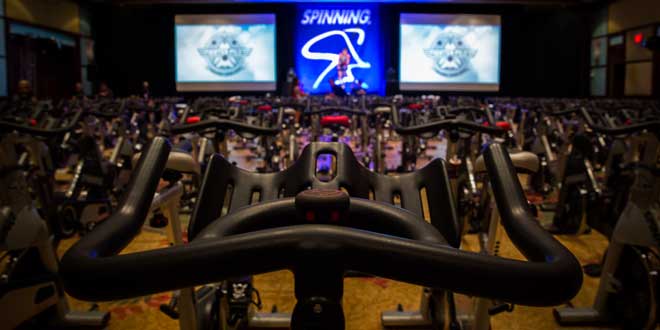By Chere LucettDrenched with sweat, gasping for air and hoping that timer would just shut up, I end up falling in love with high intensity interval training (HIIT). And here is why you should too: it’s a fitness game changer that can take your fitness and health to the next level (no matter what level you are) in just a few minutes flat.Maybe fitness superheroes have hours to spend in the gym, but everyday Janes and Joes like myself don’t have that luxury (or desire) to spend more than thirty minutes start to finish to get our sweat on! High intensity interval training gets the job done and boasts several amazing benefits like (Giannaki, et al., 2015; Naimo, et al., 2015; Shiraev, et al., 2012):• Aerobic and anaerobic fitness• Blood pressure• Cardiovascular health• Insulin sensitivity• Fat loss (with an emphasis on abdominal fat)• Performance enhancementHIIT is all the rage right now, and I don’t see it waning any time soon because it’s not a passing fad. It’s a science-backed method of training. However, to ensure a safe and effective HIIT training program, there are four key factors to consider when creating the optimal HIIT program for yourself or your clients. Intensity, duration, frequency, and recovery are the four most important pillars to consider when designing your programs and each has an important impact on the program results.
Can you handle the intensity?
If you or your clients aren’t putting forth maximum effort, you’ll get minimal results. The nature of interval training is to safely push the boundaries of capability, expanding your anaerobic threshold to increasing your aerobic and anaerobic fitness while increasing your calorie burn before and after your HIIT session. (Milanović, Sporiš, & Weston, 2015) To obtain a higher level of intensity, your effort should amount to 80% or more of your maximum intensity. On the RPE scale of 1–10, you or your clients would be between an 8 and 10.
How long is long enough?
HIIT intervals are not to be performed for long durations. With a high intensity program, the intervals are intended to be short so that the individual performing the activity in that interval can give his or her all (or at least 80% or more of their all). If the duration of the interval is too long, the participant will not be able to sustain their intensity level and could end up vulnerable to injury. The duration of each work interval should not last longer than 2 minutes, with a complete session of combined intervals lasting no longer than 30 minutes. Beginners, or those transitioning into interval training, should work with a shorter duration of intervals and a smaller number of intervals in totality. For example, beginners would perform work for an interval of 10 seconds, enjoy a longer rest interval and accomplish 4–5 of these intervals per session. Advanced exercisers would extend their work intervals to 30–45 seconds and reduce their rest intervals to shorter time bouts, as well as perform more intervals per session.
Again? So soon?
More isn’t always better. Frequency and recovery are important aspects of this training program. Too many HIIT training sessions may lead you or your clients towards overtraining, injuries due to fatigue and a reduction in exercise response. In short, participating in HIIT training sessions without sufficient rest and recovery in between will hamper your results. Again, in this situation, more is not better – in some cases, it could be less results. Give yourself at least 48 hours in between these demanding sessions to allow your energy levels to recuperate.
Know when to give it a rest.
Rest periods between intervals and rest days between HIIT sessions are important factors to consider. To get the most out of your efforts, remain safe and prevent injuries, it’s important to program in the proper rest and recovery time periods. Recovery intervals are generally at 40–50% of maximum intensity – or a 2–6 on the RPE scale. In the very early stages of a HIIT program, allow yourself greater recovery times and more rest days in between sessions. As you become more advanced or if you are a seasoned athlete, skew your rest times towards shorter rest periods and more intervals performed. If you are an athlete in a particular sport looking to increase performance, time your work-to-rest intervals to match the demands of a typical spurt of activity within your sport. For example, if you are a tennis player, you may work for a volley for 15–30 seconds before a short rest interval once a point is scored. In that scenario, you would time your work-rest intervals at 15–30-second intervals of max effort followed by 30–45-second intervals of rest and recovery.There is no doubt HIIT training will continue to pervade the fitness industry with people like you and I who have limited time available to exercise. HIIT is a great method of obtaining your fitness goals in a shorter period of time with even more efficiency and greater results. Here’s the kicker though – it’s not easy. Prepare for a tough workout that will leave you screaming for mercy. After all, it’s an all out effort and not for the faint of heart. At least not at first!For more workout tips,
subscribe to our newsletter!
REFERENCES
Giannaki, C.D., Aphamis, G., Sakkis, P., & Hadjicharalambous, M. (2015). Eight weeks of a combination of high intensity interval training and conventional training reduce visceral adiposity and improve physical fitness: A group-based intervention. Journal of Sports Medicine and Physical Fitness. [Epub ahead of print]Milanović, Z,. Sporiš, G., & Weston, M. (2015). Effectiveness of high-intensity interval training (HIIT) and continuous endurance training for VO2max improvements: A systematic review and meta-analysis of controlled trials. Sports Medicine,.45(10),1469-1481.Naimo, M.A., de Souza, E.O., Wilson, J.M., Carpenter, A.L., Gilchrist, P., Lowery, R.P., Averbuch, B., White, T.M., & Joy, J. (2015). High-intensity interval training has positive effects on performance in ice hockey players. International Journal of Sports Medicine,36(1),61-66.Shiraev, T., & Barclay, G. (2012). Evidence based exercise - clinical benefits of high intensity interval training. Australian Family Physician,41(12),960-962.






Leave a comment
This site is protected by hCaptcha and the hCaptcha Privacy Policy and Terms of Service apply.